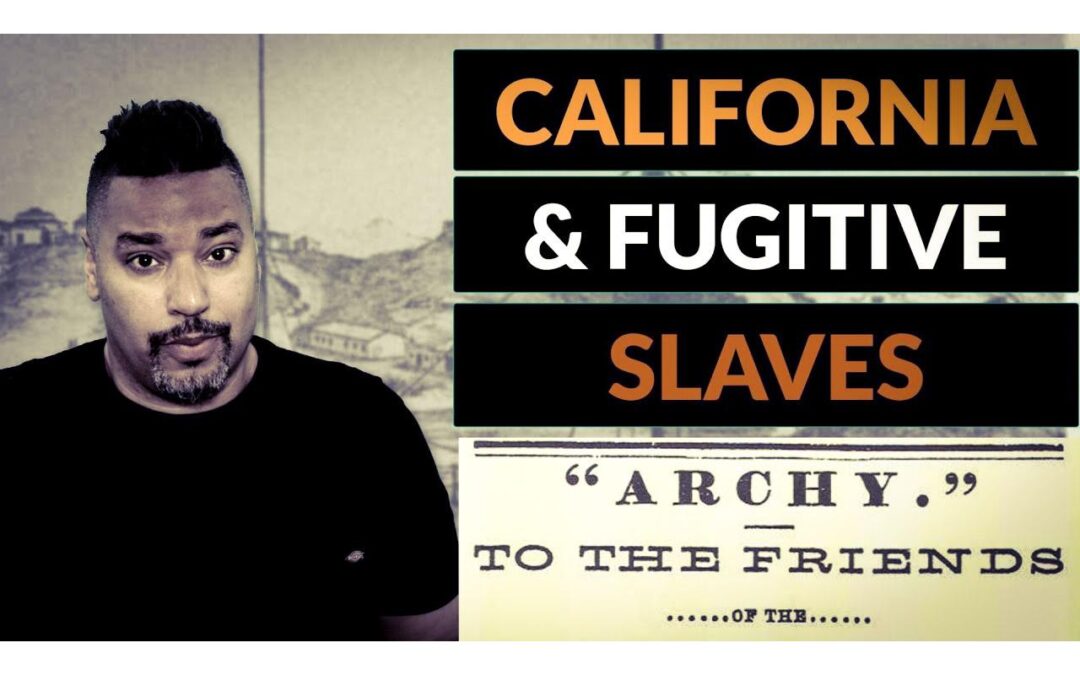*Ad Free Videos for as little as $1/Month Subscription!!*
California, The Fugitive Slave, and the Compromise of 1850
Explore the ways the Compromise of 1850 impacted the placement of California’s eastern border and the struggle to keep slavery out of California…and ex-slaves in it.
By Darius Spearman (africanelements)
About the author: Darius Spearman is a professor of Black Studies at San Diego College, where he has been pursuing his love of teaching since 2007. He is the author of several books, including Between The Color Lines: A History of African Americans on the California Frontier Through 1890. You can visit Darius online at africanelements.org.
Introduction:
The history of California’s statehood is a complex tapestry woven with the threads of the slavery debate that dominated the United States in the mid-19th century. The sectional conflict over slavery played a pivotal role in shaping not only California’s geographical boundaries but also its societal and political landscape.
California’s Eastern Border and the Slavery Debate:
The history of slavery and sectional debate impacted the formation of California in a variety of ways. California’s admission into the Union and the Compromise of 1850 intensified the sectional conflict over slavery bringing the United States one step closer to Civil War. The hidden history of the slavery debate in the mid-19th century becomes visible in the very placement of California’s eastern border. Additionally, California becomes a central point in Black history as African Americans struggled to keep slavery out of California…and Black people in it.
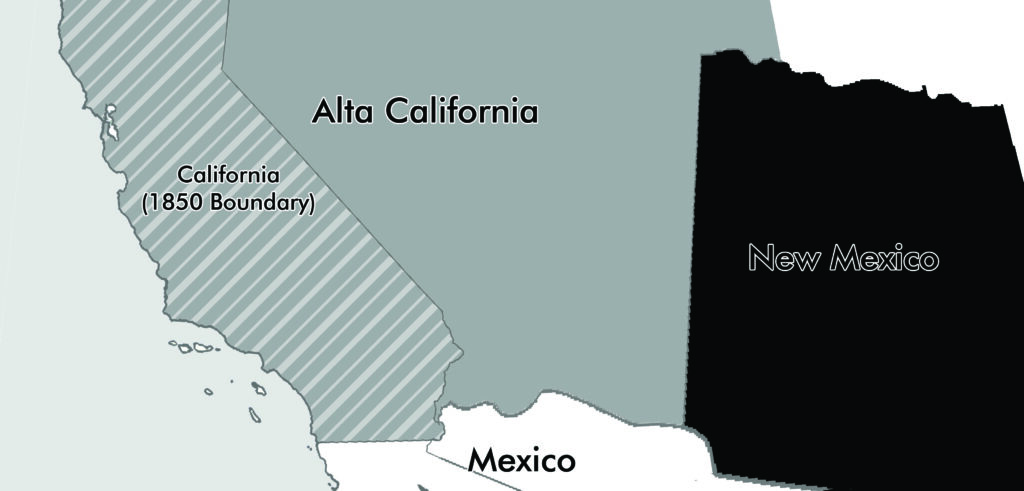
In early 1848, the Treaty of Guadalupe Hidalgo marked the end of the Mexican-American War. By the terms of the treaty, Mexico ceded its territory of Alta California to the United States. The additional territory sparked yet another debate over the sectional balance between slaveholding and non-slaveholding interests (for more on that, click here).
Nevertheless, in 1849, 48 delegates representing 11 California districts met to establish a state constitution. A look at the debate proceedings reveals that slavery was hotly debated during the convention and became an issue right off the bat, even as the delegates were considering the border of California itself. As a region of northern Mexico, Alta California roughly consisted of the territory stretching from the Pacific just north of San Francisco all the way east to the Rockies and South to the present-day border of Mexico.
The enormous land cession roughly comprised the four states of present-day California, Nevada, Arizona, and Utah. The convention quickly recognized that given the intense sectional debate between slaveholding and non-slaveholding states at that time, carving a single state from such a large territory would be problematic. Intense wrangling over the congressional balance between the slaveholding and non-slaveholding states had already delayed the entry of Texas into the Union. It was not for another ten years that the addition of the state of Oregon provided the needed balance. Kimball Dimmick, Chair of the California State Constitutional Convention committee, noted, “I have always been opposed to this extreme eastern boundary… It is very nearly equal to the whole of the non-slaveholding States of the Union.” Rodman Price, another delegate at the convention, reiterated that including Alta California in its entirety would… “produce contention and discord in Congress, and prevent our admission into the Union. It will be utterly impossible to go into the Union with that boundary.” (Browne 138)
The problem was that incorporating the state under the Alta California boundary would roughly double the size of the free territory. As such, it drastically upset the balance of congressional representation in favor of the non-slaveholding States. For that reason, the delegates moved California’s eastern border to the crest of the Sierra Nevada in order to gain any chance of gaining congressional approval to join the Union.
California’s Anti-Slavery yet Anti-Black Stance:
It is clear from the debate proceedings that California’s entry into the Union as a slaveholding territory was a nonstarter. There was no chance that that was going to happen. With the boundary issue settled, the convention unanimously determined that California would enter the Union as a non-slaveholding state. To understand why we have to look at the composition of convention delegates and the nuances that lie between the varying interests among the slaveholders themselves.
Given the delegation’s composition, it becomes clear why the question of slavery in particular and Black people in general came to dominate the debates. While the most significant percentage of delegates originated from the Northern states (46%), Southerners made up a large block of 29%. Significantly, though, none of the delegates were native to the leading cotton-producing states of the Deep South, which include Georgia, Alabama, Mississippi, and Louisiana. All but two of the delegates of Southern origin were from the border states of Missouri, Kentucky, Maryland, and Virginia. Nearly two-thirds of the Southern delegates originated from states that would later remain loyal to the Union during the Civil War. (Spearman 74-75)
In the context of the debate over slavery in California, it is crucial to understand that between 1830 and 1860, the institution of slavery itself was becoming increasingly monopolistic. Two distinct classes of slaveowners emerged as there was a general thinning of the institution in the border states of the Upper South.
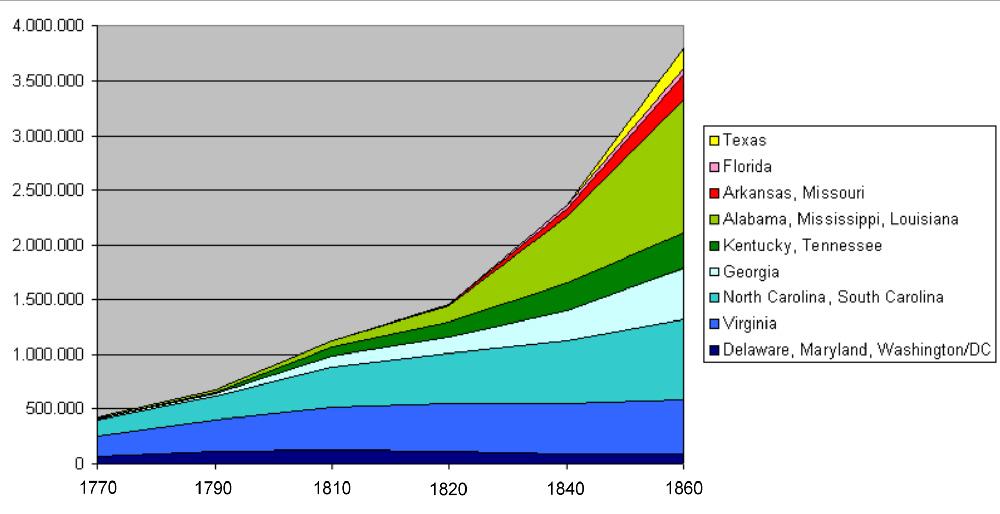
From 1830 to 1860, the percentage of Southern whites who owned slaves dropped dramatically from 36% to 4.7 %. Out of less than 5% of those Southern whites who owned slaves, only 12%, owned more than 20 slaves, and just 1 percent owned more than 50 slaves. That 1% resided primarily on the plantations of the Deep South. (Hine 128)
Adding to that trend and feeding the growing monopolization of slaves amongst fewer and fewer slaveowners was the domestic slave trade. Since the closing of the international slave trade in 1808, the slave states of the upper South had established a business of “breeding” and trafficking slaves to feed the growing demand in the Deep South. Due to the domestic slave trade, from 1820 and 1860 approximately 50 percent of slaves from the Upper South were trafficked to the Deep South. (Spearman 73-75) There they were concentrated into the hands of increasingly fewer slaveholders. Many small-scale slaveowners – those who owned less than twenty slaves – found it more profitable to sell individuals to the deep south plantations “down the river.” In the Upper South, enslaved Black brothers, sisters, and loved ones lived with the constant fear of separation from their families.
It is here that the composition of the California delegate convention becomes essential. Even though nearly 30% of the delegates were from Southern states, none of those delegates were from the leading cotton-producing states where the 1% of large-scale slaveholders resided. Less than 5% of Southerners owned slaves. Nearly 90% of that 5% were small-scale slaveowners – mainly from the Upper South, where most of California’s delegates from the South originated. Even the slave-owning class in the Upper South feared the influx of slaveowners from the Deep South, where plantations holding enslaved Africans could number in the hundreds. According to one of the convention delegates permitting slavery in Gold Rush California “… would become a monopoly of the worst character. The profits of the mines would go into the pockets of single individuals.”
So, while the delegates unanimously decided that admitting slavery in Gold Rush California was off the table, the decision was far from a moral proclamation against the institution of slavery. The evidence for that is in the debate proceedings. While the delegates to the 1849 California Constitutional Convention barred slavery in California, some sought to bar free African Americans from entering the state altogether.
The general trend toward the thinning of slavery in the upper South partially explains why. Small-scale slave owners sought to wring out every last bit of profit from the institution of slavery, which, for them, was otherwise not hugely profitable. They did so primarily in three ways. The first was to sell them down the river to the large-scale slaveowners, as we discussed earlier. The second was by hiring them out for a number of years and collecting the wages as was the case with Mary Ellen Pleasant — a Black woman who came to California in 1852 and became such a political powerhouse that she became known as “The Black City Hall.” The third way small-scale slave owners sought to make quick profits from slavery where Black California enters the political stage. Black migration into California became a primary concern among the delegates of the state constitutional convention.
Might California become a dumping grounds for slaveowners looking to make a quick buck by allowing enslaved African Americans to purchase their freedom at once by being put to work in the California gold mines during the gold rush era? A look at the debate proceedings reveals that Henry Amos Teft of New York directly addressed the question:
…in a short time from this, hundreds of negroes would be brought here for the purpose of being liberated after they have worked a short time in the gold mines. What will be the result? Do you suppose the white population of this country will permit these negroes to compete with them in working the mines? (Browne 138)
Robert Semple of Kentucky (a slaveholding state) pointed out,
Suppose you pay seven hundred dollars to get a slave here, and set him free, on condition that he shall serve you for one year. He produces, according to the ordinary rates in the mines, from two to six thousand dollars. There are many of our Southern friends who would be glad to set their negroes free and bring them here if they produced only half of that amount. When the terms of the contract have expired, what would these slaves do? They would become a burden on the community. (Browne 138)
And according to Jacob Snyder’s calculation,
What is a negro worth in Missouri? That is, taking the average value—say $600. …Then the slave will yield two hundred dollars a year from the time he is sixteen until he is fifty years of age, which will net the owner $6,800 up to the time that he may be considered useless, to say nothing of sickness or death.
Now suppose that the slaveholder will say, ‘Mose, if you will go with me to California, I will give you your freedom after working there for four years ;’
… A working man in the mines by one year’s labor will procure $4,000 at least in gold dust, which at the same rate for four years will be $16,000, leaving the handsome sum of $9,200, more by one half than what the negro would have paid by working his whole life in Missouri. (Browne 138)
While banning slavery, mid 19th century California legislators also fought to prevent free black people from immigrating to or living in the state . At the convention debates, the newly elected governor, Peter Burnett took the podium declaring that “It could be no favor, and no kindness, to permit [free blacks] to settle in the State,” he said, “while it would be a most serious injury to us….Had they been born here, and had acquired rights in consequence, I should not recommend any measures to expel them…the object is to keep them out.” (history.com)
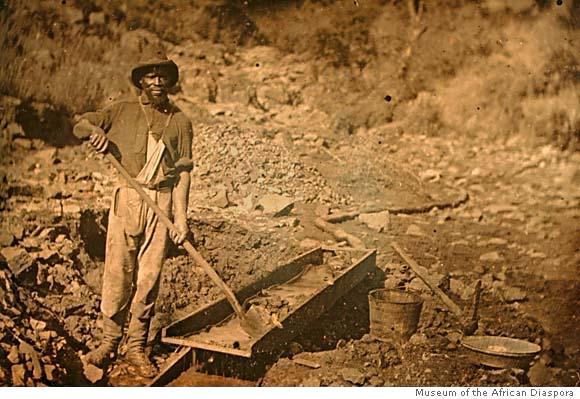
The California state legislature introduced measures throughout the 1850s to ban Black people altogether. Although they ultimately failed, the California State Legislature did succeed in legally codifying white supremacy. They did so by passing laws that denied California’s Black residents voting rights. Additionally, California banned Blacks the right to testimony against white people in court, jury service, marriage with whites, and homesteading. So, the final product of the California State Constitutional Convention was a constitution that was simultaneously anti-slavery and anti-Black. Despite efforts to keep African Americans out of California, Black Californians paid an estimated $750,000 to purchase freedom for themselves and their families in the decade before the Civil War. (Lapp 74)
The Compromise of 1850 and Its Impact:
As we can see, the debate was contentious, but even more so on a national scale. California’s admission into the Union required some concessions from the non-slaveholding northern section. The Compromise of 1850 brought California into the Union and brought the nation one step closer to Civil War. The slaveholding states accepted California’s admission as a non-slaveholding state in exchange for a few minor provisions and one major one – the Fugitive Slave Act of 1850. The act of Congress strengthened the existing fugitive slave law allowing slave owners to retrieve runaway slaves from non-slaveholding territories.
Additionally, it required that persons in free territories cooperate with the return of fugitive slaves. Those found in violation or those caught harboring fugitive slaves faced a $1000 fine and six months in prison. The fugitive slave act effectively turned poor white people who did not own slaves (and) into active and often unwilling agents of slaveholding interests. Often the slave-owning class undermined the interests of non-slaveholding whites. As such, even many whites who opposed slavery on practical if not moral grounds were infuriated.
By 1852 there was a shift in the political composition of California’s capital city of Sacramento. With it, the worst fears of the California Constitutional convention were realized when the State legislature passed its version of the Fugitive Slave Law. California’s fugitive slave law that passed the legislature on April 9, 1852, took the national fugitive slave act of 1850 even further. By the provisions of the law, enslaved African Americans seeking freedom in Gold Rush California need not even be fugitives. Enslaved African Americans brought to California by their slaveowners had to be returned even though California had ostensibly banned slavery. As a result, by the time Civil War broke out in April 1861, California had more enslaved Black population than any state or territory west of the Mississippi except Texas.
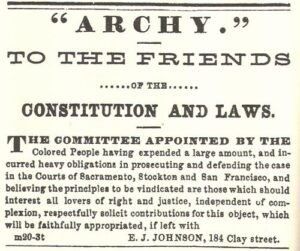
Poor white residents in California who came to strike it rich during the gold rush era competed with gangs of slave labor that the state seemingly invited in despite the so-called ban. Californian’s Black population, and with the so-called ban non-slaveholding whites were having none of it. During the course of California’s most famous case involving African Americans and the fugitive slave act, the Archy Lee case of 1858, riots broke out in front of the courthouse on Kearny St. in San Francisco that involved physical confrontations not only between whites and African Americans but between whites and other whites.
Conclusion:
As we can see, the debate over slavery figured prominently in California’s state constitutional convention. It was a key factor in determining the placement of the state’s border. The Compromise of 1850 that brought California into the Union largely inflamed sectional tensions both within the state and on a national level bringing the United States one step closer to the Civil War. Those tensions weren’t necessarily centered around the morality of slavery but rather around slaveholding versus non-slaveholding interests. One of the things that the history of Black California helps us understand is that it is entirely possible to be simultaneously anti-slavery and anti-Black.
Sources
Blakemore, Erin. “California Once Tried to Ban Black People.” History.com, A&E Television Networks, 9 Feb. 2018, www.history
Browne, John Ross. Report of the Debates in the Convention of California on the Formation of the State Constitution, in September and October, 1849 (J. T. Towers, 1850).
Hine, Darlene Clark, et al. African Americans: a Concise History. Pearson, 2014.
Lapp, Rudolph M. Blacks in Gold Rush California. Yale University Press, 1977.

